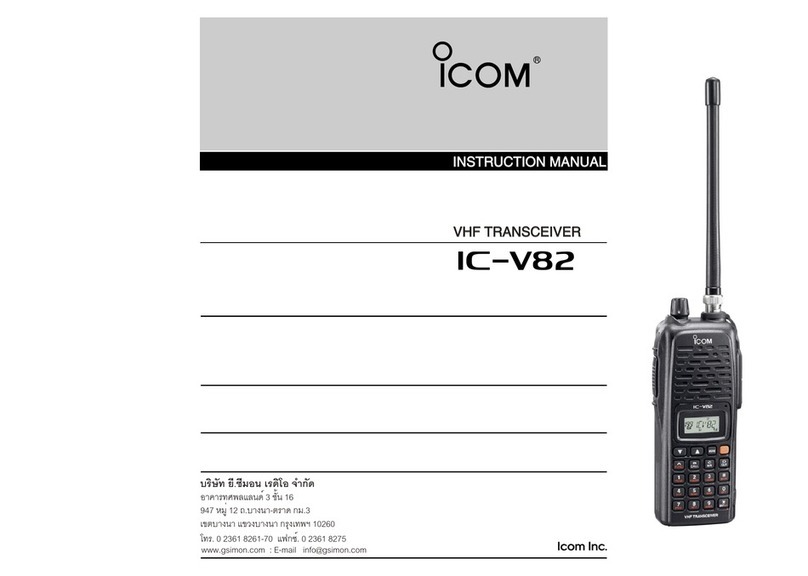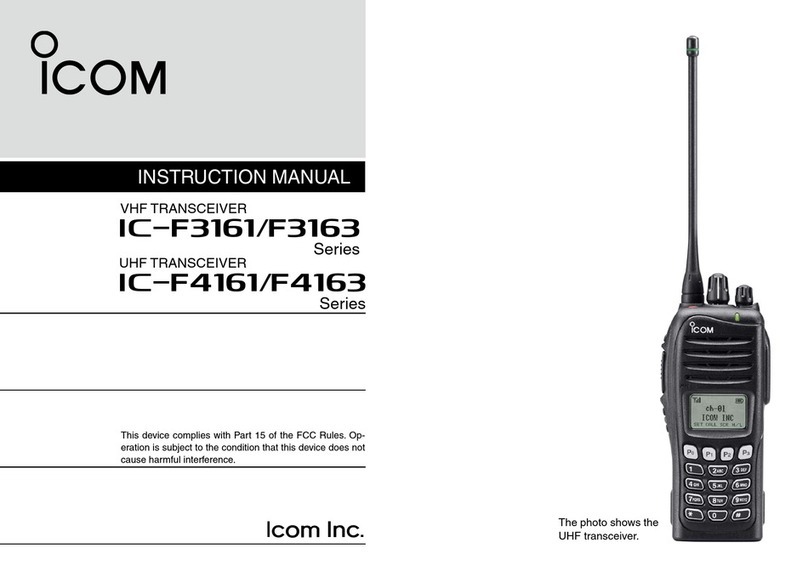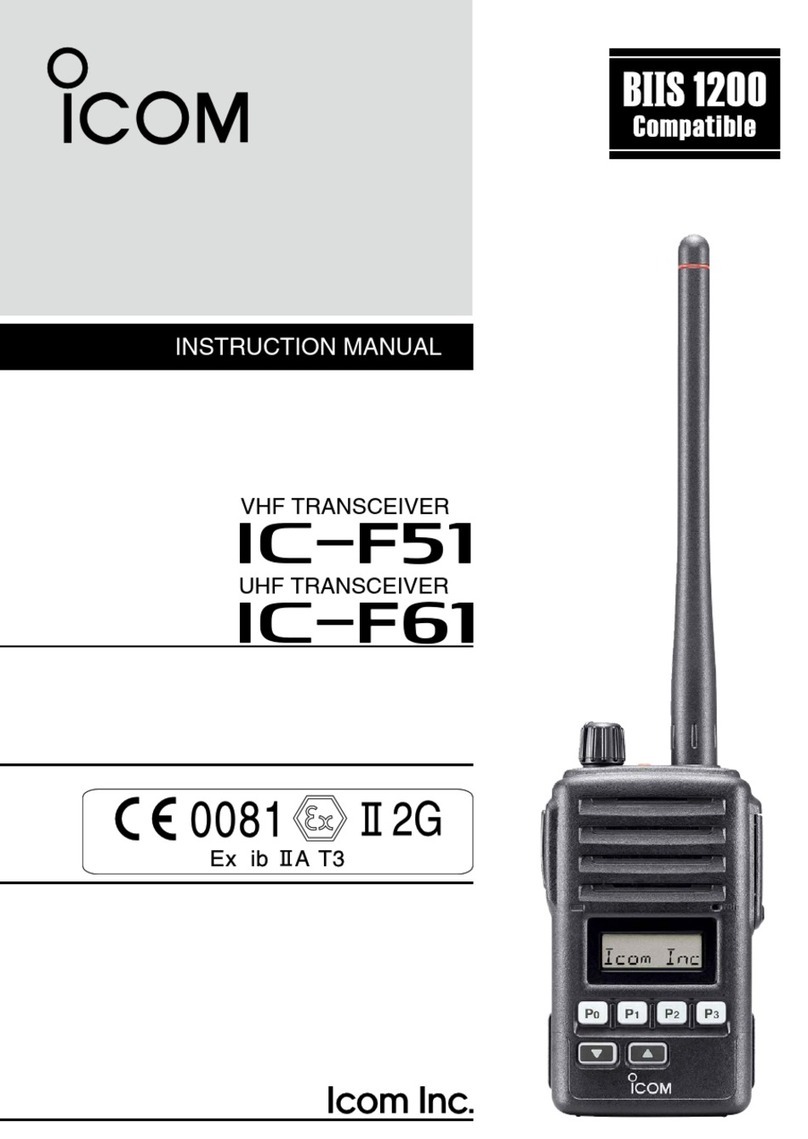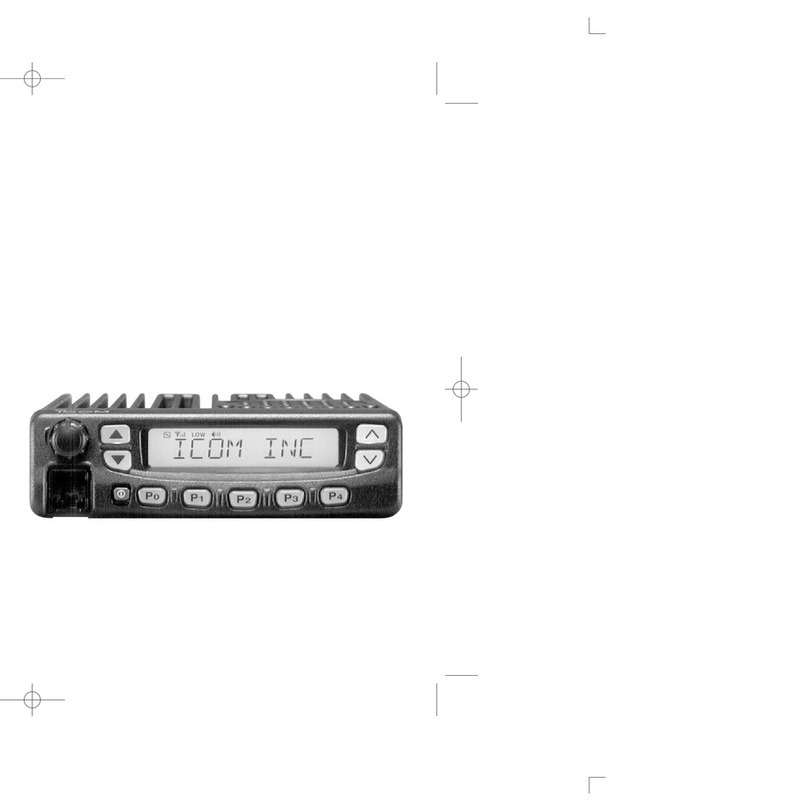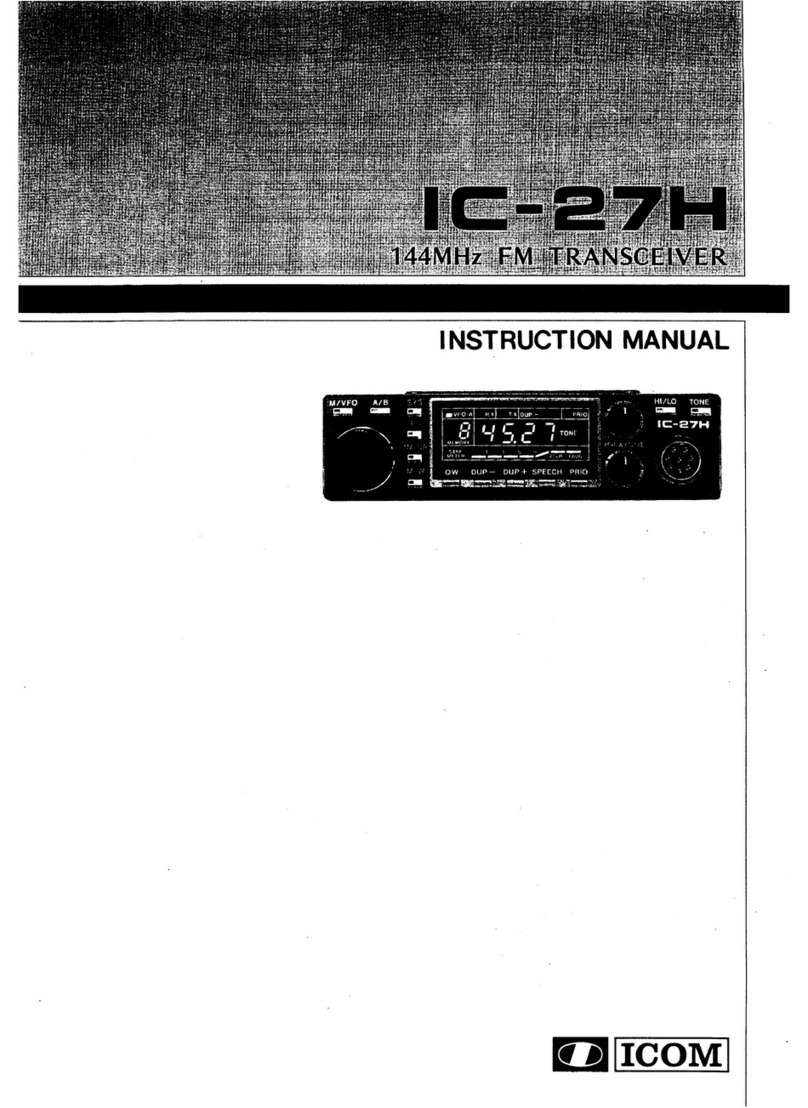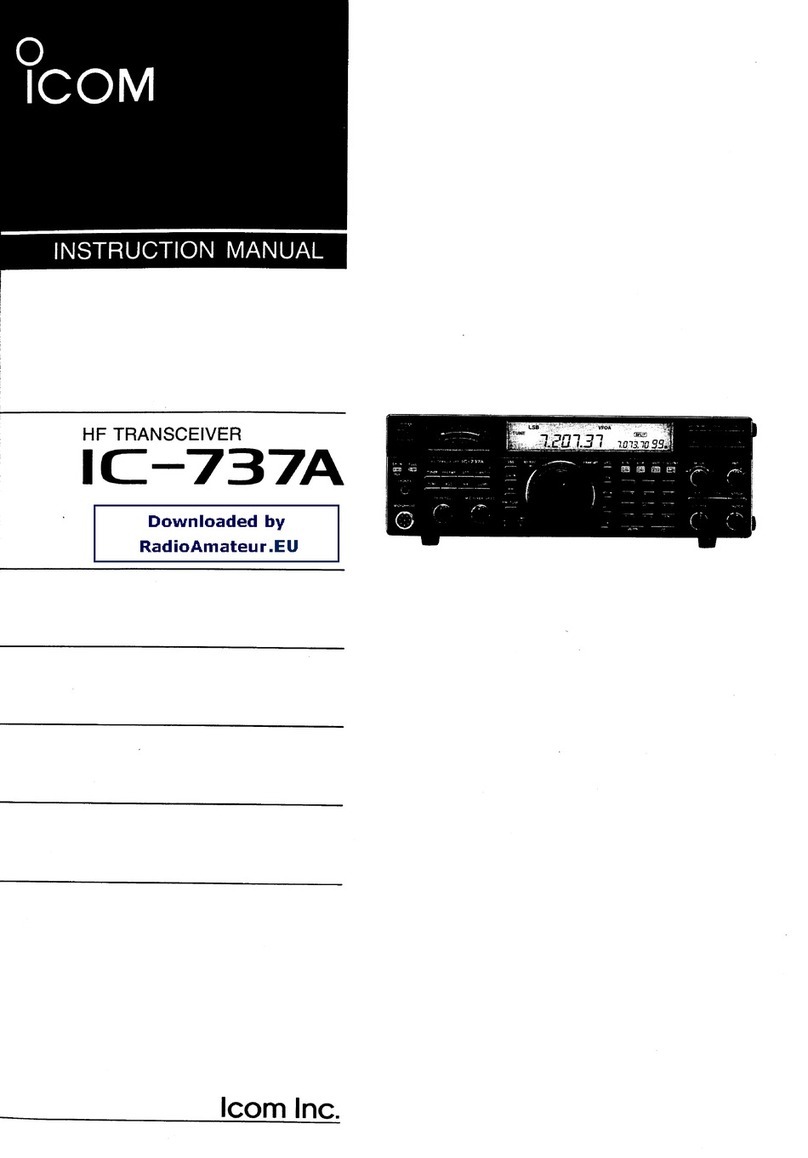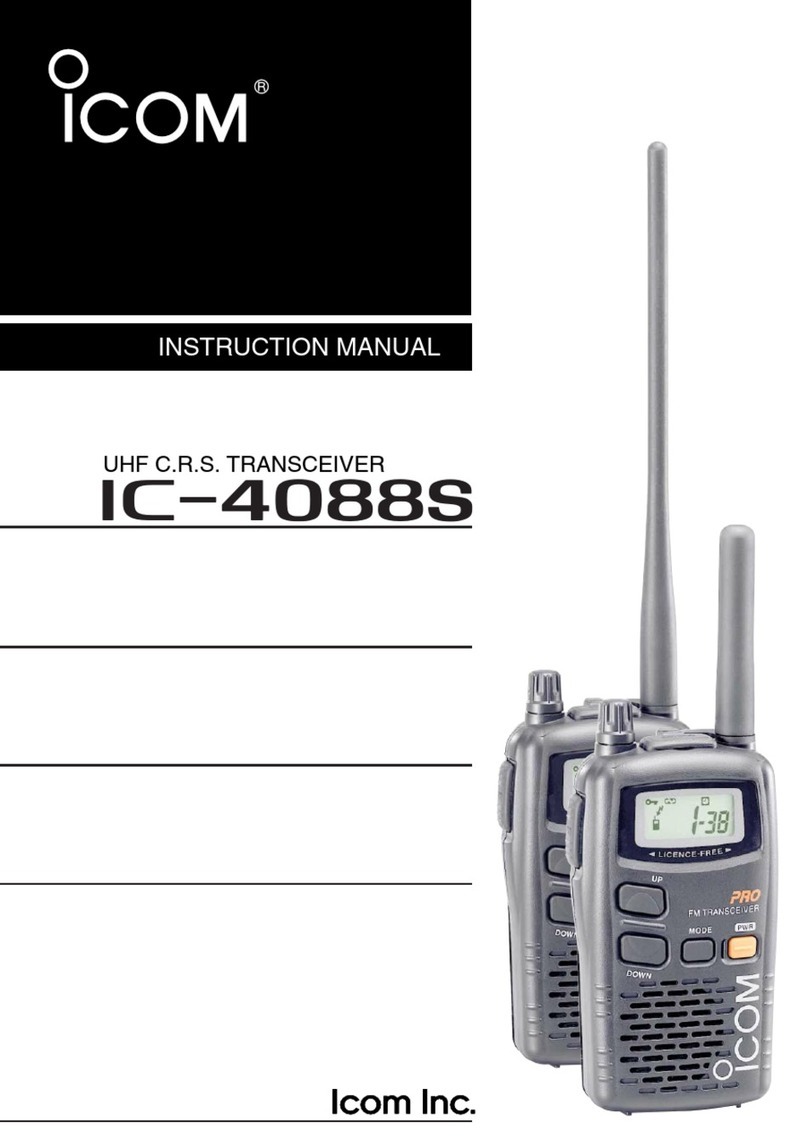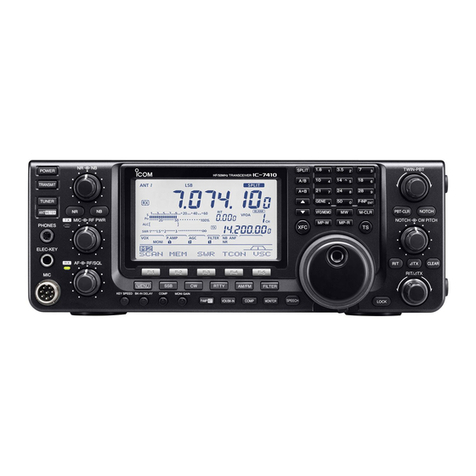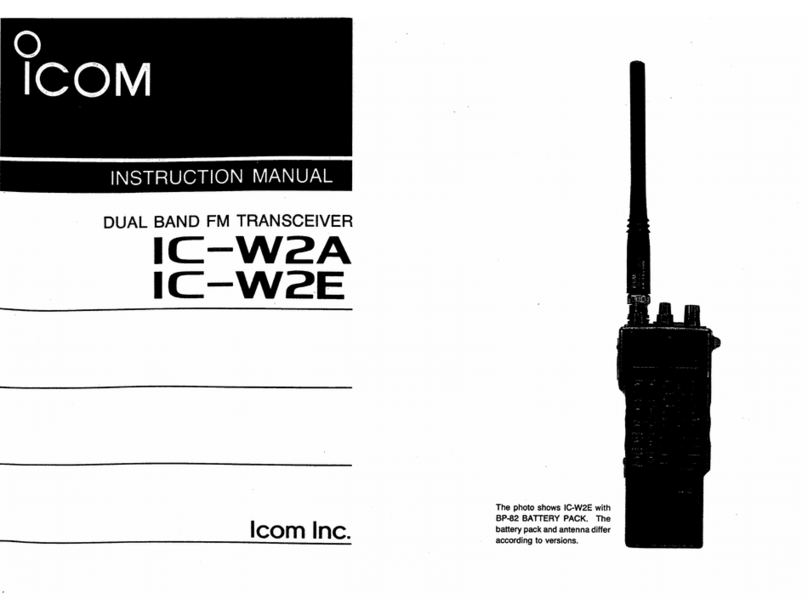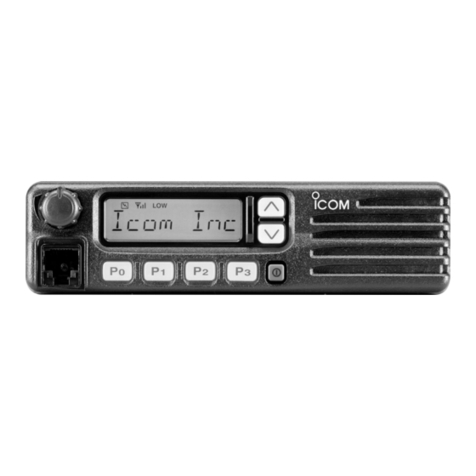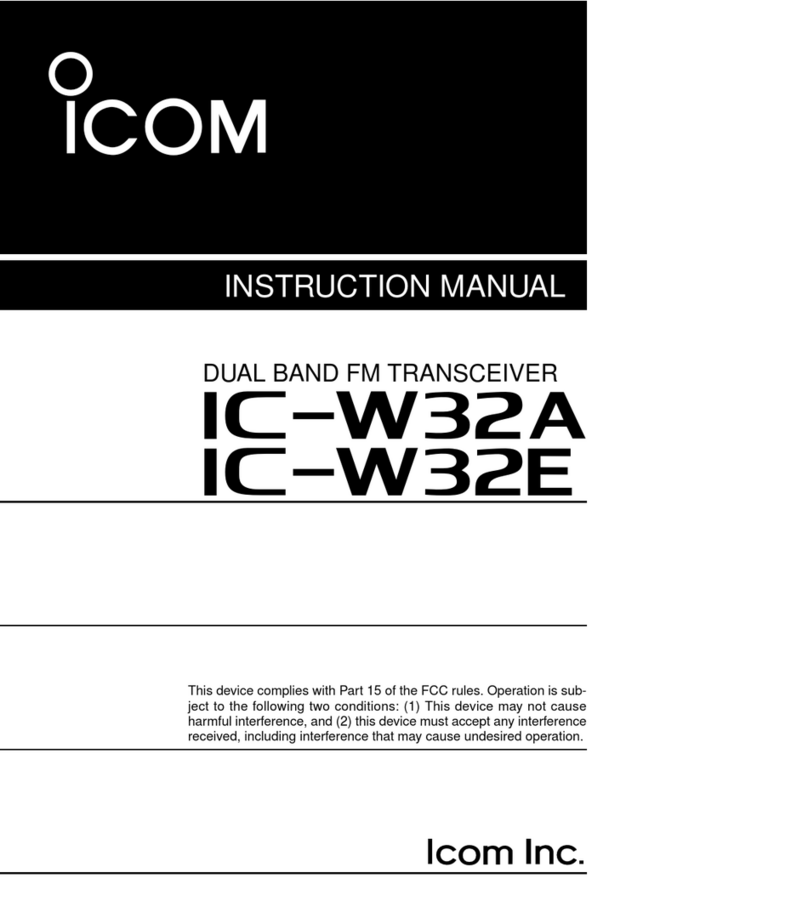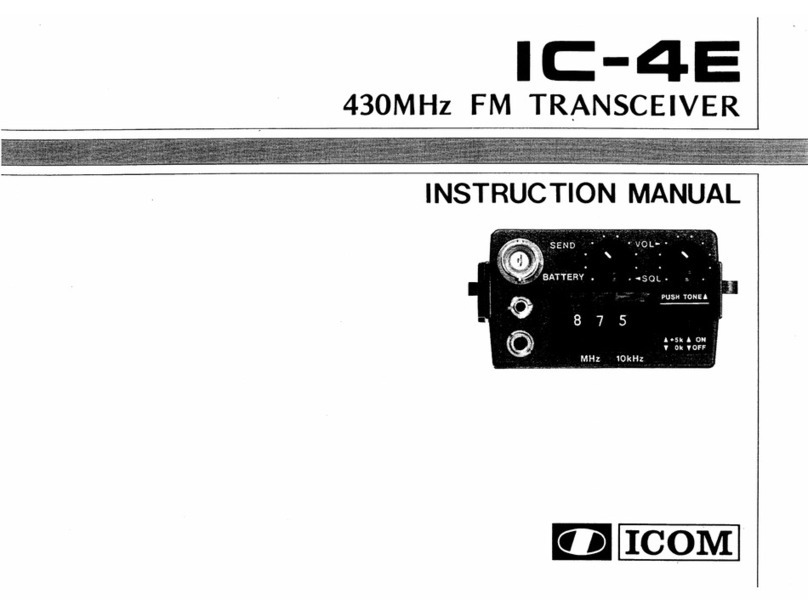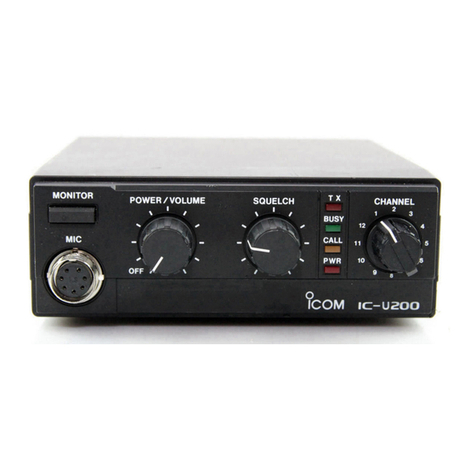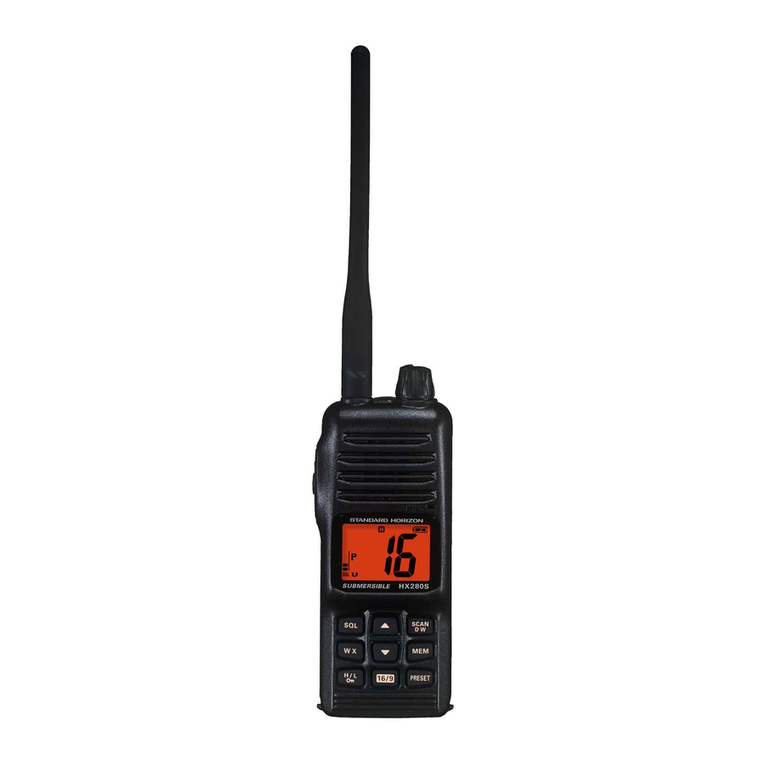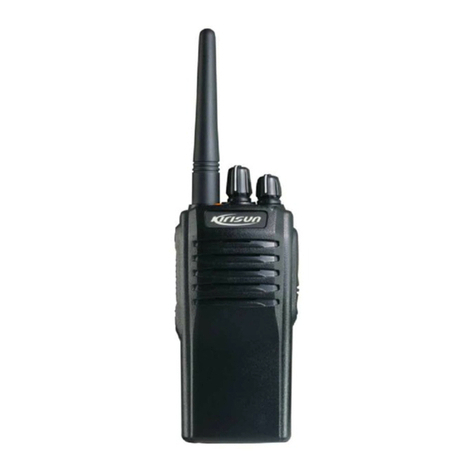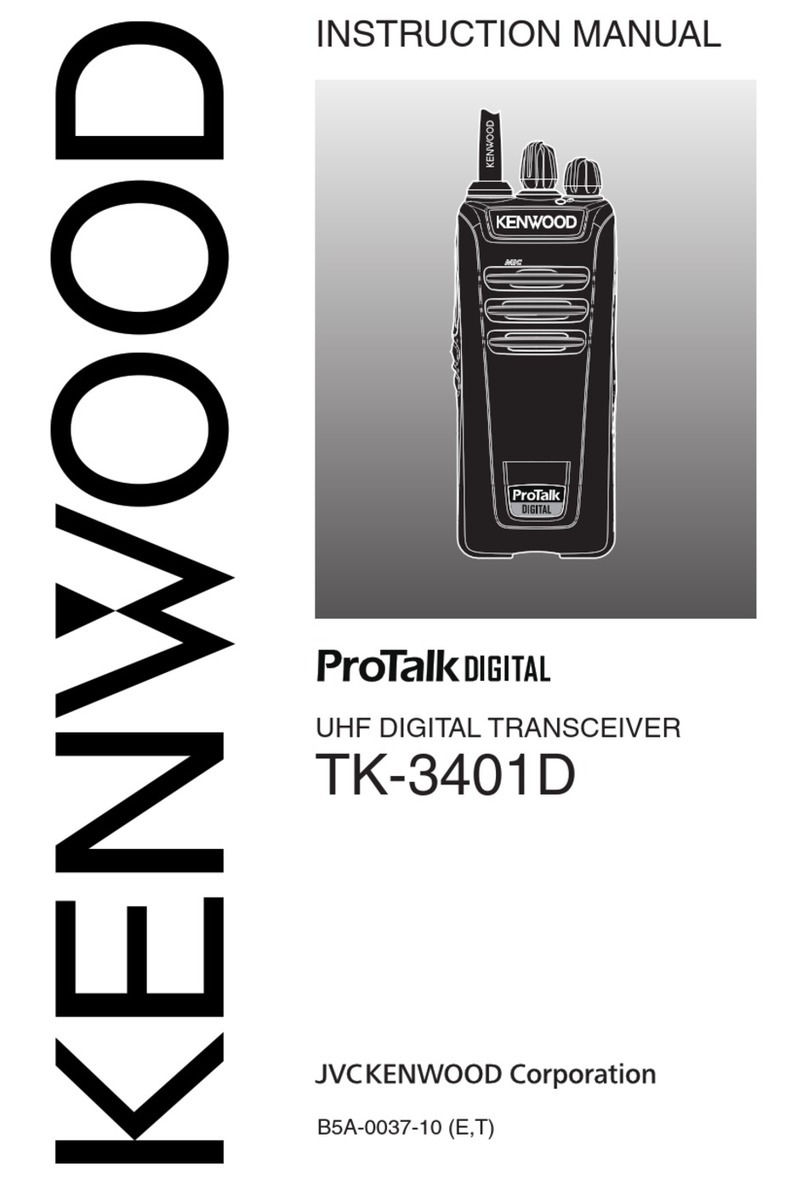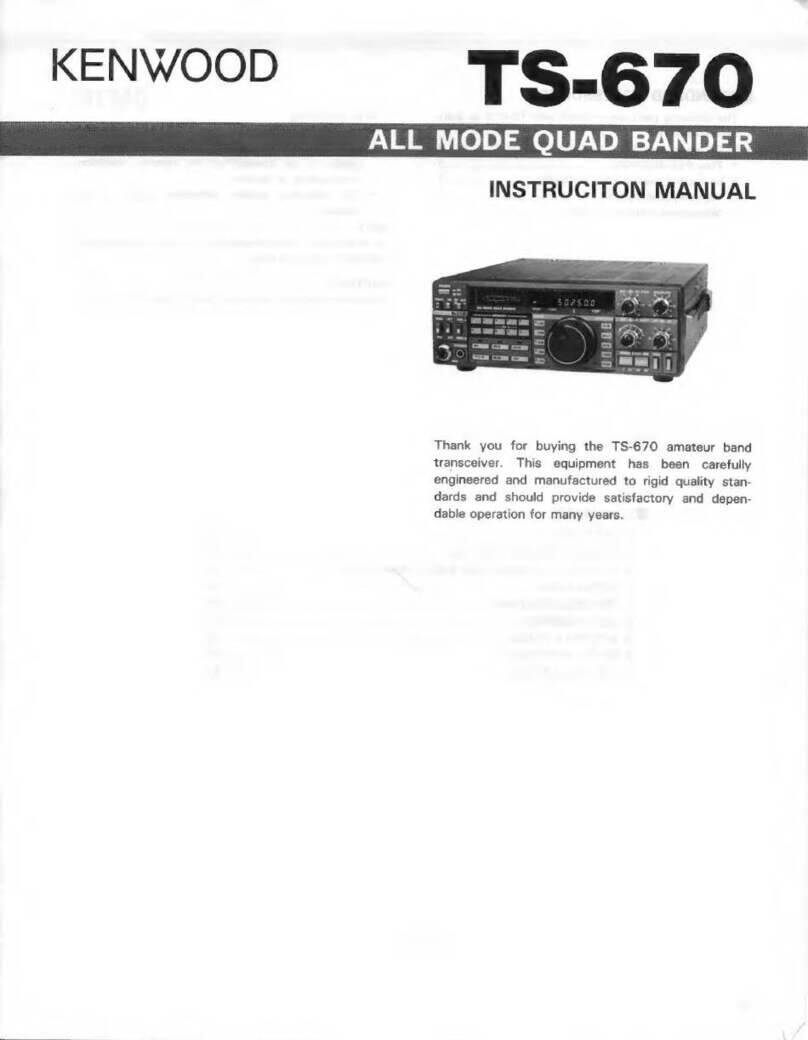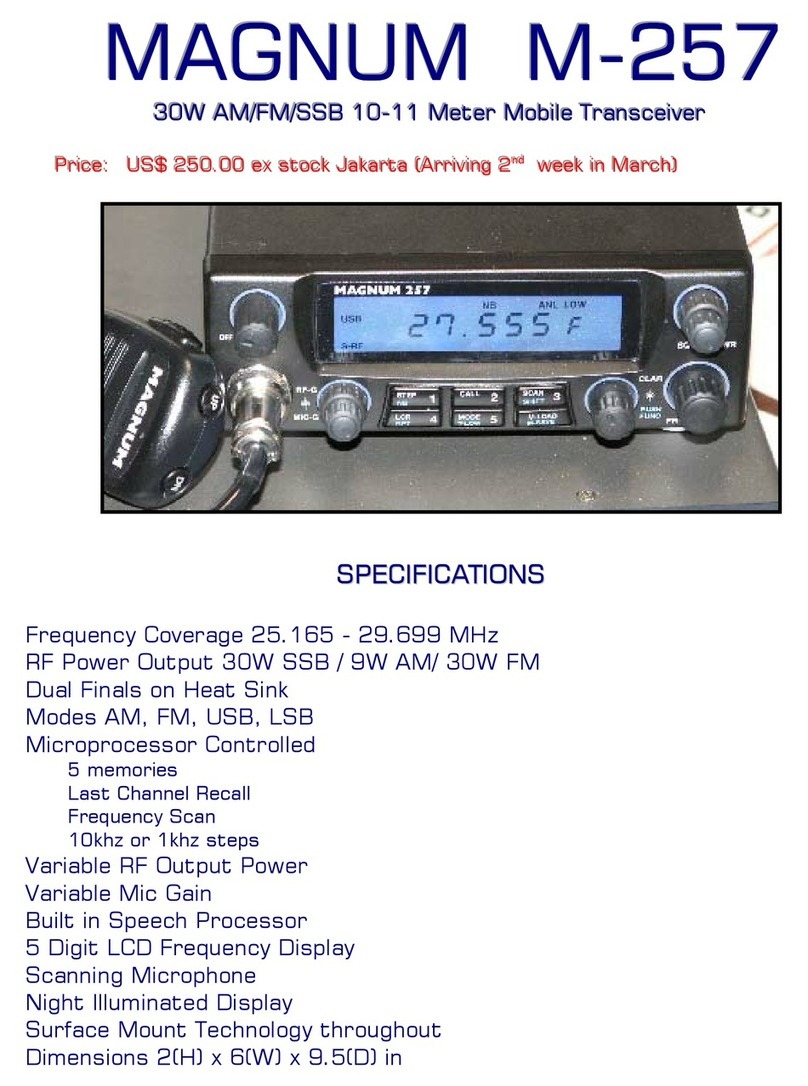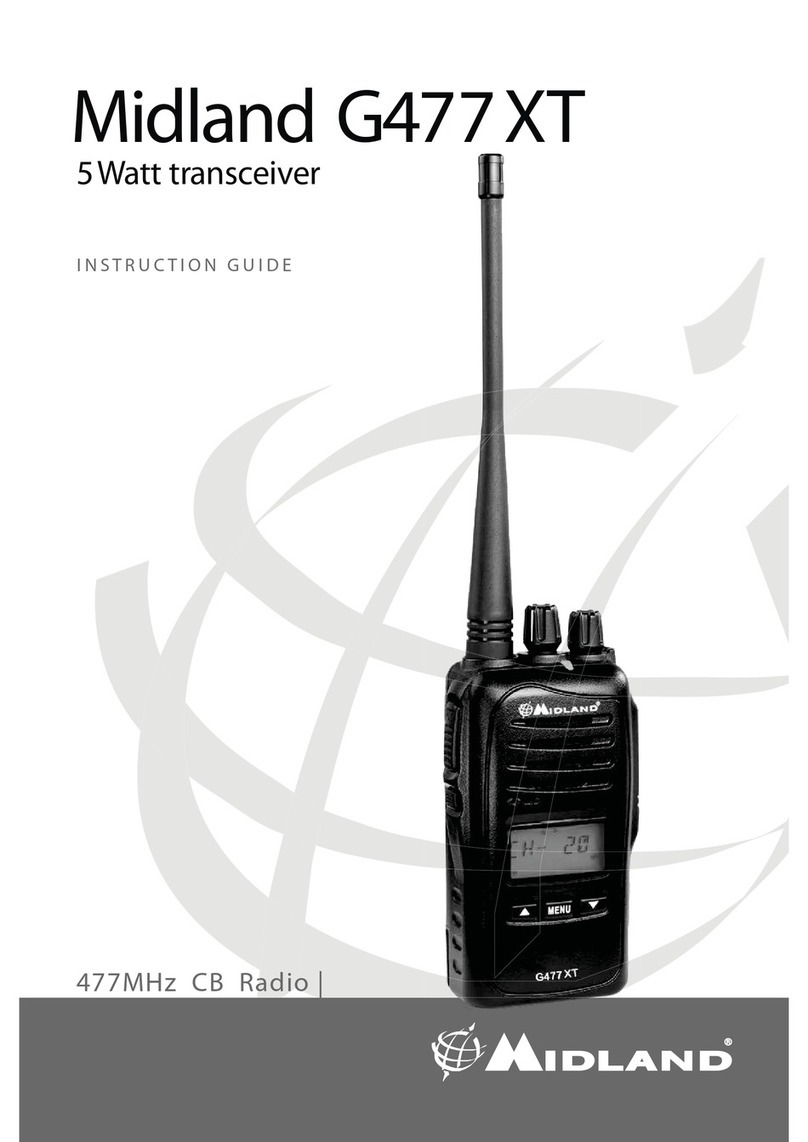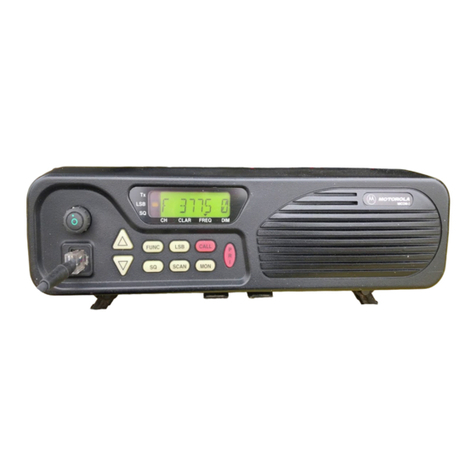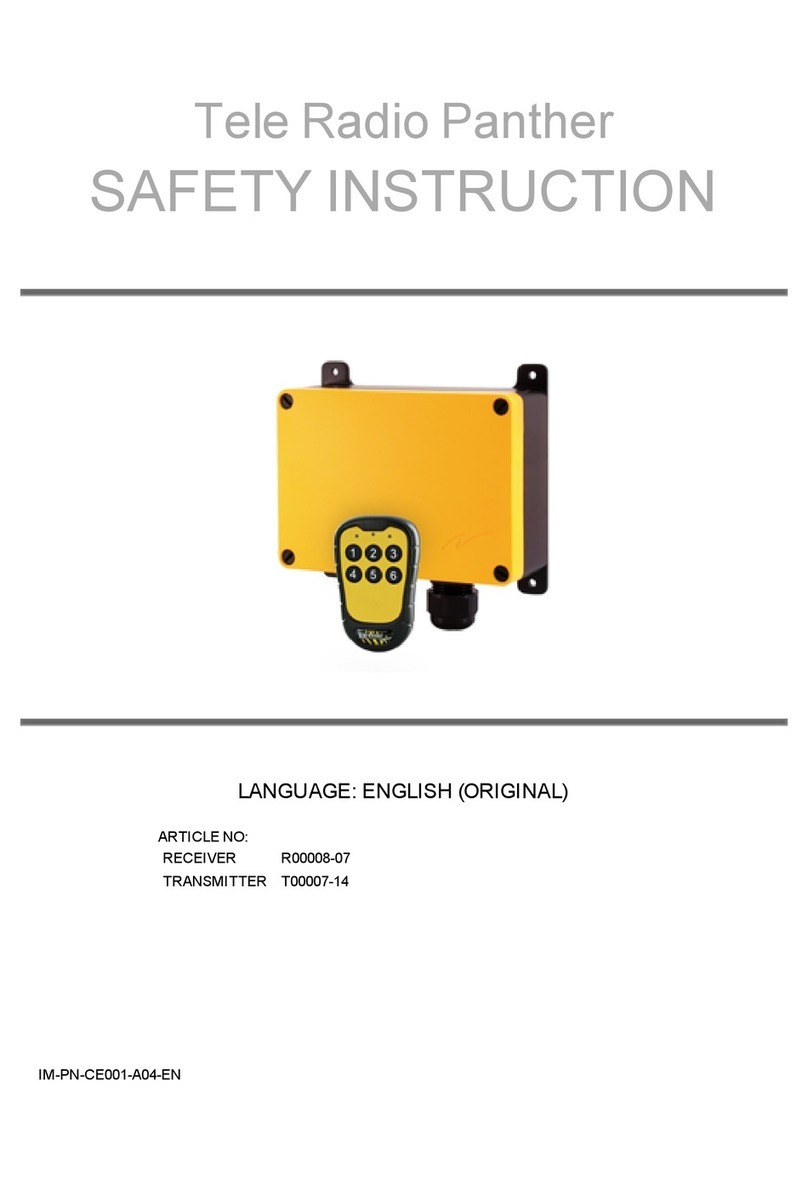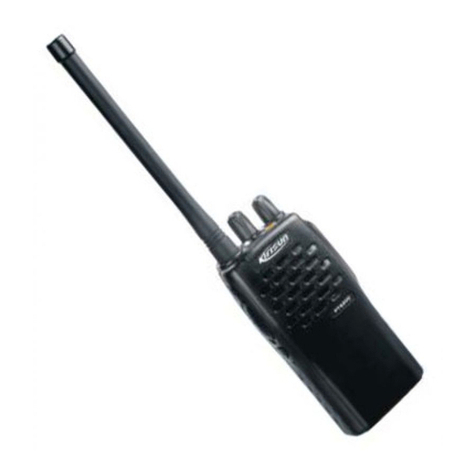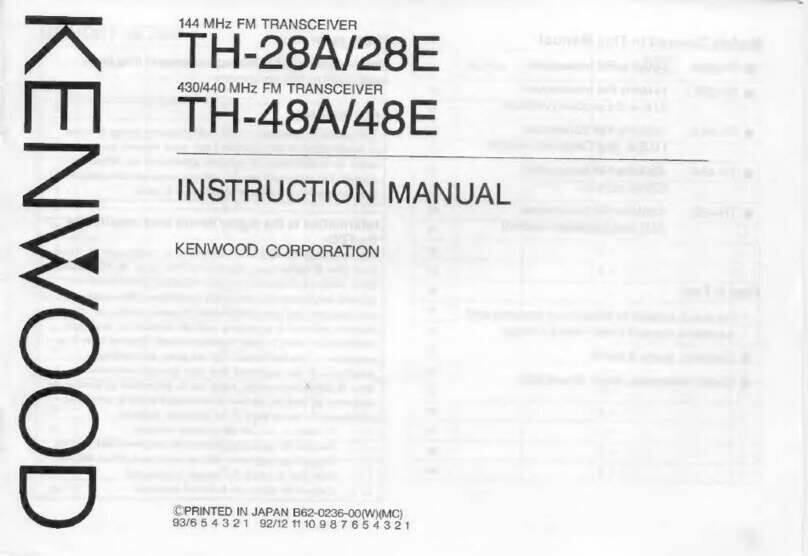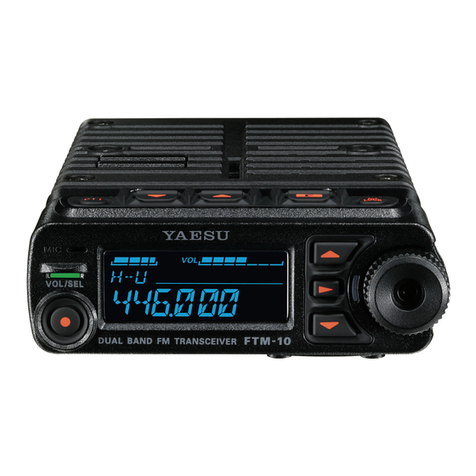Icom IC-F22SR User manual

New master
INSTRUCTION MANUAL
PMR446 FM TRANSCEIVER
iF22SR
IC-F22SR_4.qxd 06.11.1 1:21 PM Page 1

New master
i
FOREWORD
Thank you for purchasing the IC-F22SR PMR446 FM trans-
ceiver. This PMR FM transceiver meets the European PMR446
specification. This transceiver is designed for those who require
top-grade quality, performance and outstanding reliability under
the most demanding conditions.
FEATURES
●
Free of user-license and applications
●
All 8 PMR channels and Auto Scan channel are
available
●
52 convenient CTCSS tone channels
●
83 convenient DTCS tone channels also available
●
Rugged construction
●
500 mW (ERP) High output power
Icom, Icom Inc. and the logo are registered trademarks of Icom Incorpo-
rated (Japan) in the United states, the United Kingdom, Germany, France, Spain,
Russia and/or other countries.
IC-F22SR_4.qxd 06.11.1 1:21 PM Page 2

New master
ii
■2 types of built-in Code Squelch Systems:
CTCSS; Continuous Tone Coded Squelch System
DTCS; Digital Tone Code Squelch
CTCSS* and DTCS* encoder/decoder are standard, providing
quiet stand-by. Audio (voice) signals are output only when a sig-
nal with a matched CTCSS or DTCS tone signal is received—
very helpful for group communications. (pgs. 14, 26)
*Select one of CTCSS or DTCS for your convenience.
■2 types of “Ring” function
The “Smart-Ring”* function and the “Call-Ring” function are avail-
able for smart and simple station calls providing a telephone-
style ring when called. 16 different ringing tones are available.
(pgs. 19–20)
*“Smart-Ring” function available only when all of your group sta-
tion use the same CTCSS tone code on the same operating
channel.
SUPPLIED ACCESSORIES
•Belt clip (w/screws)………………………………………………1
•Battery charger …………………………………………………1 set
DAttach the belt clip to the transceiver as illustrated below.
Use the supplied screws only.
IC-F22SR_4.qxd 06.11.1 1:21 PM Page 3

New master
iii
IMPORTANT
READ ALL INSTRUCTIONS carefully and completely
before using the transceiver.
SAVE THIS INSTRUCTION MANUAL— This instruc-
tion manual contains important operating instructions for
the IC-F22SR PMR446 FM transceiver.
CAUTIONS
RWARNING! NEVER hold the transceiver so that the an-
tenna is very close to, or touching exposed parts of the body,
especially the face or eyes, while transmitting. The transceiver
will perform best if the microphone is 5 to 10 cm away from the
lips and the transceiver is vertical.
RWARNING! NEVER operate the transceiver with a
headset or other audio accessories at high volume levels.
DO NOT push the PTT when not actually desiring to transmit.
DO NOT modify the transceiver for any reason.
AVOID using or placing the transceiver in direct sunlight or in
areas with temperatures below –25°C or above +55°C. In an
extreme low temperature environment (around –25°C), the ca-
pacity of Alkaline or dry cell batteries may exhaust quickly. In
such case, we recommend to replace the batteries, when the
“Low Battery” warning appears during transmission.
The use of non-Icom battery packs/chargers may impair trans-
ceiver performance and invalidate the warranty.
IC-F22SR_4.qxd 06.11.1 1:21 PM Page 4

New master
iv
TABLE OF CONTENTS
FOREWORD ………………………………………………………………… i
FEATURES ……………………………………………………………… i–ii
SUPPLIED ACCESSORIES ……………………………………………… ii
IMPORTANT ……………………………………………………………… iii
CAUTIONS ………………………………………………………………… iii
TABLE OF CONTENTS …………………………………………………… iv
1 PANEL DESCRIPTION ……………………………………………… 1–3
‘Switches, controls, keys and connectors ………………………… 1–2
‘LED indicator …………………………………………………………… 3
2 BATTERY PACKS …………………………………………………… 4–10
‘Battery pack replacement …………………………………………… 4
‘Battery cautions ……………………………………………………… 5
‘Battery charging ……………………………………………………… 6
‘Charging NOTE ……………………………………………………… 9
‘Battery case (Option) ………………………………………………… 10
3 BASIC OPERATION ……………………………………………… 11–18
‘Receiving and transmitting ………………………………………… 11
‘Setting squelch level ………………………………………………… 13
‘Auto scan function …………………………………………………… 13
‘Setting the group code number ………………………………… 14–18
4 RING FUNCTION ………………………………………………… 19–20
‘Smart-Ring …………………………………………………………… 19
‘Call-Ring ……………………………………………………………… 19
5 OTHER FUNCTIONS ……………………………………………… 21–23
‘Monitor audible function …………………………………………… 21
‘Time-Out Timer ……………………………………………………… 21
‘Power save function ………………………………………………… 22
‘Low battery indication ……………………………………………… 22
6 SPECIFICATIONS ……………………………………………………… 23
7 OPTIONS ……………………………………………………………… 24
8 GLOSSARY ………………………………………………………… 25–26
9 CE …………………………………………………………………… 27–28
‘DECLARATION OF CONFORMITY ……………………………… 28
IC-F22SR_4.qxd 06.11.1 1:21 PM Page 5

New master
1
1PANEL DESCRIPTION
‘‘Switches, controls, keys and
connectors
SP MIC
Antenna
q[CH] selector
Speaker
MIC
w[VOL/ POWER]
e[S-Ring/
C-Ring] key
r[PTT]
t[MONI] key
Ext. MIC
Ext. SP
External
[SP]/[MIC] jack
(see below)
u
TX/RX
Indicator LED
y
External
[SP]/[MIC] jack
u
IC-F22SR_4.qxd 06.11.1 1:21 PM Page 6

New master
2
PANEL DESCRIPTION 1
qCHANNEL SELECTOR [CH]
•Rotate the selector to select the desired channel number 1 to
15. (pgs. 11, 12)
•Select the Auto Scan channel No.16. (p. 13)
•Select the Call-Ring melody. (p. 19)
wVOLUME/POWER CONTROL [VOL/POWER]
•Rotate the [VOL/POWER] clockwise to turn the power ON/OFF.
Along power ON beep emits when turning the power ON.
•Rotate clockwise to increase and counterclockwise to decrease
the audio volume.
eSMART-RING/CALL-RING KEY [S-Ring/C-Ring]
•Push to send a Smart-Ring call. (p. 19)
•Push and hold to send a Call-Ring. (p. 19)
rPTT SWITCH [PTT]
•Push and hold to transmit; release to receive.
tMONITOR KEY [MONI]
•Push and hold to open the noise/tone squelch.
• Push to turn the tone squelch ON.
yTX/RX INDICATOR LED [LED]
• Lights red while transmitting.
• Lights green while receiving a signal, or squelch is open.
•Lights orange while sending/receiving a Smart-Ring call. (p. 19)
•Indicates the Low-battery condition. (p. 3)
uEXTERNAL SPEAKER AND MICROPHONE JACKS [SP]/[MIC]
•Connects an optional speaker-microphone.
IC-F22SR_4.qxd 06.11.1 1:21 PM Page 7

New master
3
1PANEL DESCRIPTION
‘‘LED indicator
The TX/RX indicator LED indicates informa-
tion in several ways as follows;
(Ref.; R=Red, G=Green, O=Orange)
[Brink patterns]
R R R R
R R
R R R R
R R
G
R
O O
GG
•TX: Turns Red while transmitting a signal.
•RX (Busy): Turns Green while receiving a signal.
•Smart-Ring: Calling or answering back the Smart-Ring now.
•Fast/Slow scan: CH scanning or CTCSS FIND is functioning now.
•Low BATT1: You should charge the battery. (blinks slowly)
•Low BATT2: You must charge the battery. (blinks fast)
CAUTION:
Low BATT3: If you did not charge the battery after Low BATT2
warning has appeared, the Low BATT3 warning beep emits for 15
sec. then the power turns OFF automatically.
•TX low BATT1: Low BATT1 was detected during TX mode.
•TX low BATT2: Low BATT2 was detected during TX mode.
IC-F22SR_4.qxd 06.11.1 1:21 PM Page 8

4
2
BATTERY PACKS
New master
‘‘Battery pack replacement
Before replacing the battery pack, the volume control MUST be ro-
tated fully counterclockwise, until a click is heard, to turn the power
OFF.
•Slide the battery release forward, then pull the battery pack up-
ward with the transceiver facing away from you.
DDBATTERY PACKS
*1BC-144N cannnot charge Li-Ion battery pack, BP-211N.
*2Operating period is calculated under the following conditions;
Tx : Rx : standby = 5 : 5 : 90
*3Operating period depends on the alkaline cells used.
7.2 V 1100 mAh
Battery
pack Voltage Capacity BC-146 Battery life*2
BC-144N*1,
BC-119N or
BC-121N
Charging period
BP-208N Battery case for AA
(LR6) ×6 alkaline N/A N/A
12 hrs. 1.5 hrs. 14.5 hrs.
—*3
BP-209N
1800 mAh 23 hrs.2.0 hrs.N/A7.4 V
BP-211N
600 mAh 8 hrs.1.0 hrs.6.5 hrs.7.2 V
BP-222N
1650 mAh 21.5 hrs.2.0 hrs.18.5 hrs.7.2 V
BP-210N
IC-F22SR_4.qxd 06.11.1 1:21 PM Page 9

5
2BATTERY PACKS
New master
‘‘Battery cautions
• CAUTION! NEVER short the terminals of the battery pack (or
charging terminals of the transceiver). Also, current may flow into
nearby metal objects such as a necklace, so be careful when plac-
ing battery packs (or the transceiver) in handbags, etc.
Simply carrying with or placing near metal objects such as a neck-
lace, etc. causes shorting. This will damage not only the battery
pack, but also the transceiver.
• NEVER incinerate used battery packs. Internal battery gas may
cause an explosion.
• NEVER immerse the battery pack in water. If the battery pack be-
comes wet, be sure to wipe it dry BEFORE attaching it to the
transceiver.
• Clean the battery terminals to avoid rust or miss contact.
• Keep battery contacts clean. It’s a good idea to clean battery ter-
minals once a week.
If your Ni-Cd or Ni-MH battery pack seems to have no capacity
even after being charged, completely discharge it, then fully charge
the battery pack again. If the battery pack still does not retain a
charge (or only very little charge), a new battery pack must be pur-
chased.
IC-F22SR_4.qxd 06.11.1 1:21 PM Page 10

6
2
BATTERY PACKS
New master
‘‘Battery charging
DRegular charging with the BC-146
The supplied* BC-146 provides regular charging of optional battery
pack with/without transceiver.
*Depends on version
DDSpacer combination.
Especially when charging the battery with the transceiver;
•Be sure to attach the spacer (Spacer B/C) to the adaptor (Spacer
A) with the orientation as follows.
•Attach the spacer (Spacer B/C) to the adaptor with the orientation
of the stamp “ ” pointing up.
NOTE: Push the notch carefully
when removing the spacer from
the adaptor.
Check orientation
and
Spacer A
Spacer B/C
IC-F22SR_4.qxd 06.11.1 1:21 PM Page 11

7
2BATTERY PACKS
New master
DRegular charging with the BC-146 (continued)
• First insert the spacer in to the BC-146, then insert the battery or
the transceiver.
• Be sure to check orientation and the spacer combination.
Avoid overcharging— Batteries must be removed from the
charger to stop charging. Batteries should
not be charged for more than 24 hours.
Turn power OFF
AC adaptor
BP-209N, BP-210N
or BP-222N only
Charging indicator
Check
orientation*
*Viewable stamps of the spacer may differ according to the
spacer combination. See p. 6 for details.
IC-F22SR_4.qxd 06.11.1 1:21 PM Page 12

8
2
BATTERY PACKS
New master
DRapid charging with the BC-121N+AD-101
The optional BC-121N allows up to 6 battery packs to be charged
simultaneously. The following are additionally required.
• Six AD-101
• An AC adaptor (may be supplied with the BC-121N depending on
version).
DRapid charging with
the BC-144N+AD-99N
The optional BC-144N pro-
vides rapid charging of op-
tional battery packs.
The following are addition-
ally required:
• One AD-99N (depends
on version).
• An AC adaptor (may be
supplied with the BC-
144N depending on ver-
sion).
Turn power OFF.
BC-144N
(Insert together
with charging
adaptor.)
Check orienta-
tion for correct
charging.
AC adaptor
(purchased
separately)
Charge indicator
(each indicator functions independently)
Turn power OFF.
AD-99N
IC-F22SR_4.qxd 06.11.1 1:21 PM Page 13

9
2BATTERY PACKS
New master
‘‘Charging NOTE
Prior to using the transceiver for the first time, the battery pack must
be fully charged for optimum life and operation.
• Recommended temperature range for charging:
+10°C to +40°C.
• Use the supplied charger or optional charger (BC-119N/BC-
121N/BC-144N for rapid charging, BC-146 for regular charging)
only. NEVER use other manufacturers’ chargers.
The optional BP-209N, BP-210N, BP-211N or BP-222N battery
packs include rechargeable Ni-Cd (Ni-MH: BP-210N, Li-Ion: BP-
211N) batteries and can be charged approx. 300 times. Charge the
battery pack before first operating the transceiver or when the bat-
tery pack becomes exhausted.
If you want to charge the battery pack more than 300 times, the fol-
lowing points should be observed:
• Avoid overcharging— Batteries must be removed from the
charger to stop charging. Batteries should not be charged for
more than 24 hours.
• Use the battery until it becomes almost completely exhausted
under normal conditions.
DDBattery pack life
When the operating period becomes extremely short even after
charging the battery pack fully, a new battery pack is needed.
NOTE for the rapid chargers : The charger rapidly charges a
battery pack to a specified level, not a completed level, to prevent
overcharging. Leave the battery pack in the charger for a few
more hours (up to 15 hours; depending on battery condition) after
the LED indicator turns green, to charge the battery completely.
IC-F22SR_4.qxd 06.11.1 1:21 PM Page 14

10
2
BATTERY PACKS
New master
‘‘Battery case (Option)
When using a BP-208N
OPTIONAL BATTERY CASE
attached to the
transceiver, install 6 AA (LR6) size alkaline batteries as illustrated
below.
DDCAUTIONS
• Use ALKALINE batteries only.
• Make sure all battery cells are the same brand, type and ca-
pacity.
• Never mix old and new batteries.
Either of the above may cause a fire hazard or damage the
transceiver, if ignored.
• Never incinerate used battery cells since internal battery gas
may cause them to rupture.
• Never expose a detached battery case to water.
If the battery case gets wet, be sure to wipe it dry before using
it.
IC-F22SR_4.qxd 06.11.1 1:21 PM Page 15

11
3BASIC OPERATION
New master
‘‘Receiving and transmitting
CHARGE the battery pack before first operating the transceiver.
The transceiver has been pre-programmed with all the PMR fre-
quency channels and CTCSS tone codes as a default. The CTCSS
tone number can be changed if required.
Receiving:
qRotate the [VOL] knob clockwise to
turn the power ON.
wRotate the [CH selector] to select the
desired operating channel.
•Setting the your group code number
if required. (pgs. 14–16)
eListen for a transmission and adjust
[VOL] to a comfortable listening level.
•[LED] turns to green, when the re-
ceived signal contains same CTCSS
or DTCS code number.
• When no transmission is heard,
push and hold [MONI] while adjust-
ing [VOL].
The transceiver is now set to receive de-
sired calls on the selected channel.
Transmitting:
Wait for the channel to become clear to avoid interference.
rWhile pushing and holding [PTT], speak into the microphone at a
normal voice level.
•[LED] turns to red.
tRelease [PTT] to return to receive.
IMPORTANT: To maximize the readability of your transmitted sig-
nal, pause a few sec. after pushing [PTT], hold the microphone 10
to 15 cm from your mouth and speak at a normal voice level.
[PTT]
[MONI]
[VOL]
[LED]
[CH selector]
*microphone
IC-F22SR_4.qxd 06.11.1 1:21 PM Page 16

12
3
BASIC OPERATION
New master
•Frequency channel/CTCSS tone list (default)
Channel
No.1
No.2
No.3
No.4
No.5
No.6
No.7
No.8
No.9
No.10
No.11
No.12
No.13
No.14
No.15
No.16
RX/TX Freq. (MHz)*1
446.00625
446.01875
446.03125
446.04375
446.05625
446.06875
446.08125
446.09375
446.00625
446.01875
446.03125
446.04375
446.05625
446.06875
446.08125
Auto Scan
CH spacing
Narrow
Narrow
Narrow
Narrow
Narrow
Narrow
Narrow
Narrow
Narrow
Narrow
Narrow
Narrow
Narrow
Narrow
Narrow
------
Tone (Hz)*2
NO
NO
NO
107.2
110.9
114.8
118.8
123.0
127.3
131.8
136.5
141.3
146.2
151.4
156.7
------
*1All operating channel frequencies are fixed.
*2CTCSS tone frequencies can be programmed by you. You can use
DTCS (Digital Tone Code Squelch) instead of CTCSS. (p. 17)
IC-F22SR_4.qxd 06.11.1 1:21 PM Page 17

13
3BASIC OPERATION
New master
‘‘Setting squelch level
The squelch circuit mutes the received audio signal depending on
the signal strength.
qWhile pushing and holding
[PTT] and [MONI], turn the
transceiver’s power ON to enter
the squelch adjustment mode.
wPush [S-Ring/C-Ring] to in-
crease the squelch level (tight
squelch) or [MONI] to decrease
the squelch level (loose
squelch).
•Squelch level will be fixed
after 1 sec.
DDOpen the squelch
•Pushing and holding [MONI] cancels the squelch function. You
can receive any signals on a channel.
•Push [MONI] to turn ON the tone squelch function again.
‘‘Auto Scan function
Auto scan function proceeds in sequence from lower channel to
higher channel numbers. Scanning searches for signals automati-
cally and makes it easier to locate new stations for contact or lis-
tening purposes.
qRotate the [CH] select knob to CH 16.
wScan starts automatically.
•TX/RX indicator LED blinks green slowly.
•When receiving a signal, scan pauses until the signal disappears.
[S-Ring/
C-Ring]
[PTT]
[MONI]
IC-F22SR_4.qxd 06.11.1 1:21 PM Page 18

14
3
BASIC OPERATION
New master
‘‘Setting the group code number
DDUSING THE CTCSS TONE CODE
The transceiver is equipped with 52 CTCSS tones. (See next page)
CTCSS operation provides communication with silent standby since
you will only receive calls from group members using the same
CTCSS tone.
You can assign a different tone to CH 1 to CH 15 independently.
qWhile pushing and holding [PTT], [S-Ring/C-Ring], [MONI], turn
[VOL] to turn the power ON.
wSelect the desired CH 1 to CH 15 that you want to assign the
CTCSS tone frequency to.
ePush and hold [S-Ring/C-Ring] until a beep (Pi) is emitted.
rPush [PTT] the necessary number of times to choose the 10 digit
of the desired code from the channel list.
tPush [S-Ring/C-Ring].
•Confirmation beep is emitted. (See next page.)
yPush [PTT] the necessary number of times to choose the 1 digit
of the desired code from the frequency list.
uPush [S-Ring/C-Ring].
iTurn the power OFF, and then ON again.
[Example]
To assign tone code No. 28 as CH1;
qWhile pushing and holding [PTT], [S-Ring/C-Ring] and [MONI],
turn [VOL] to power ON.
wSelect the CH 1, then push and hold [S-Ring/C-Ring] until a beep
(Pi) is emitted.
ePush [PTT] twice to choose the 10 digit of the desired channel.
rPush [S-Ring/C-Ring], then push [PTT] eight times to choose the
1 digit of the desired code.
tPush [S-Ring/C-Ring]. A long beep and 3 short beeps are emit-
ted.
yTurn the power OFF, and then ON again.
IC-F22SR_4.qxd 06.11.1 1:21 PM Page 19

15
3BASIC OPERATION
New master
No.
0
1
2
3
4
5
6
7
8
9
10
11
12
13
14
15
Freq.
OFF
67.0
69.3*
71.0
71.9
74.4
77.0
79.7
82.5
85.4
88.5
91.5
94.8
97.4
100.0
103.5
No.
16
17
18
19
20
21
22
23
24
25
26
27
28
29
30
31
Freq.
107.2
110.9
114.8
118.8
123.0
127.3
131.8
136.5
141.3
146.2
151.4
156.7
159.8
162.2
165.5
167.9
No.
32
33
34
35
36
37
38
39
40
41
42
43
44
45
46
47
No.
48
49
50
51
52
Freq.
233.6
241.8
250.3
254.1
270.4
Freq.
171.3
173.8
177.3
179.9
183.5
186.2
189.9
192.8
196.6
199.5
203.5
206.5
210.7
218.1
225.7
229.1
•CTCSS tone code list
:EIA/TIA standard code (Recommended to use these.)
*Reserved for Smart-Ring function (Unit: Hz)
•Confirmation beep list
●; Single beep
; Long beep
Push [PTT]
no
1 (Once)
2 (Twice)
3 (Third)
4 (Fourth)
Confirmation beep
●
●
●●
●●●
●●●●
Push [PTT]
5 (Fifth)
6 (Sixth)
7 (Seventh)
8 (Eighth)
9 (Ninth)
Confirmation beep
●●●●●
●
●●
●●●
●●●●
IC-F22SR_4.qxd 06.11.1 1:21 PM Page 20
Table of contents
Other Icom Transceiver manuals

Icom
Icom IC-F29DR User manual

Icom
Icom IC-7300 Administrator Guide
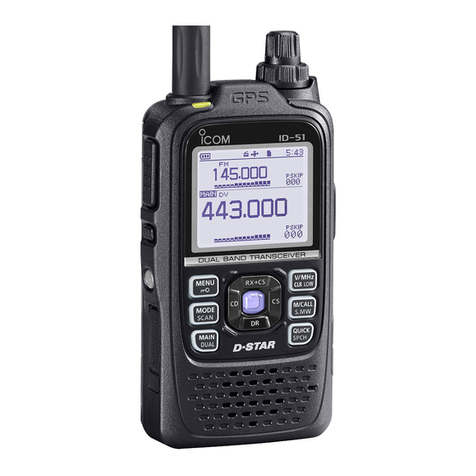
Icom
Icom ID-51A Setup guide
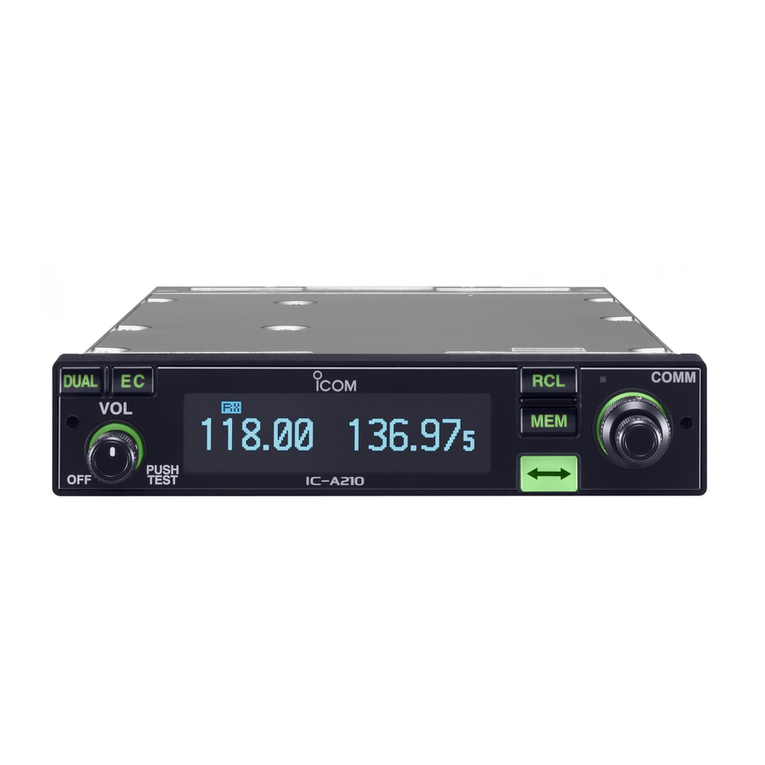
Icom
Icom IC-A210 User manual

Icom
Icom IC-F5360D User manual

Icom
Icom IC-M88 User manual
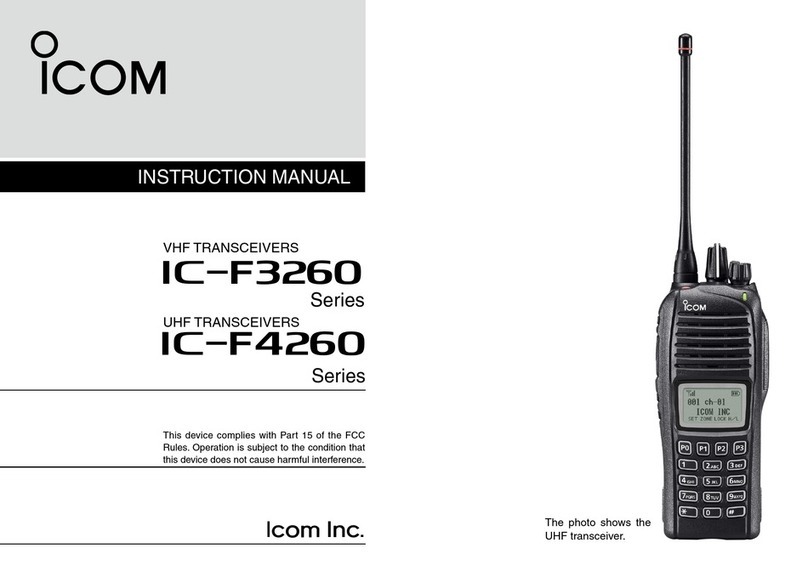
Icom
Icom IC-F3260 Series User manual
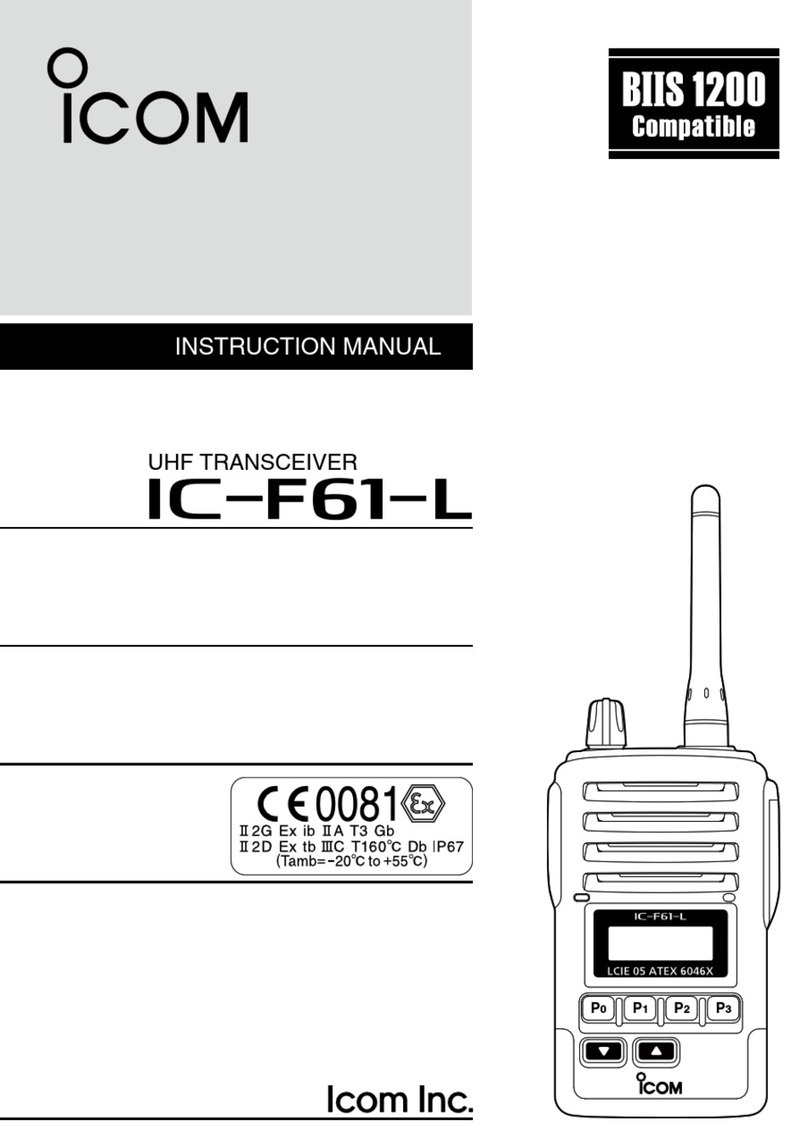
Icom
Icom IC-F61-L User manual

Icom
Icom IC-970A User manual
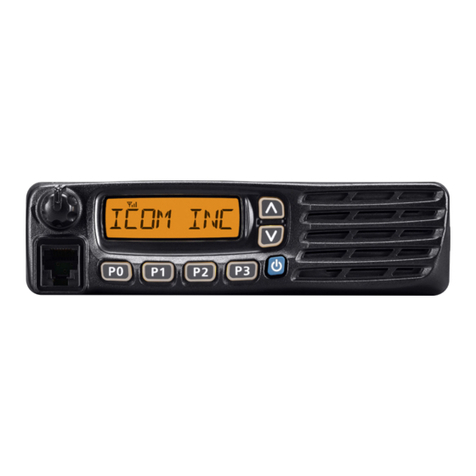
Icom
Icom IC-F5220D User manual
